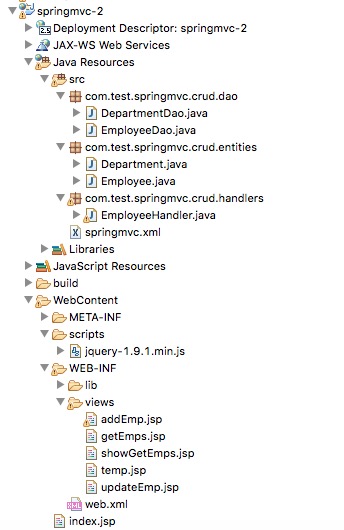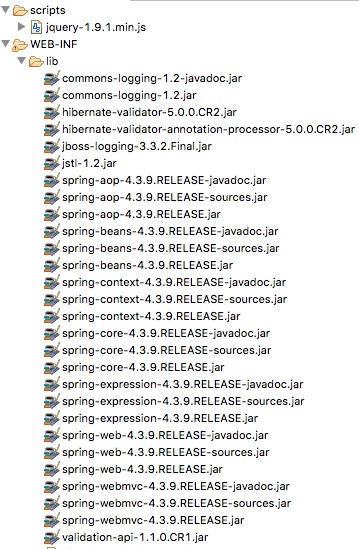一、项目代码概览
二、配置文件
1、web.xml
<?xml version="1.0" encoding="UTF-8"?>
<web-app xmlns:xsi="http://www.w3.org/2001/XMLSchema-instance" xmlns="http://java.sun.com/xml/ns/javaee" xsi:schemaLocation="http://java.sun.com/xml/ns/javaee http://java.sun.com/xml/ns/javaee/web-app_2_5.xsd" id="WebApp_ID" version="2.5">
<filter>
<filter-name>HiddenHttpMethodFilter</filter-name>
<filter-class>org.springframework.web.filter.HiddenHttpMethodFilter</filter-class>
</filter>
<filter-mapping>
<filter-name>HiddenHttpMethodFilter</filter-name>
<url-pattern>/*</url-pattern>
</filter-mapping>
<servlet>
<servlet-name>dispatcherServlet</servlet-name>
<servlet-class>org.springframework.web.servlet.DispatcherServlet</servlet-class>
<init-param>
<param-name>contextConfigLocation</param-name>
<param-value>classpath:springmvc.xml</param-value>
</init-param>
<load-on-startup>1</load-on-startup>
</servlet>
<servlet-mapping>
<servlet-name>dispatcherServlet</servlet-name>
<url-pattern>/</url-pattern>
</servlet-mapping>
</web-app>
2、转发配置器
在web.xml中已经取了名字叫: springmvc.xml
<?xml version="1.0" encoding="UTF-8"?> <beans xmlns="http://www.springframework.org/schema/beans" xmlns:xsi="http://www.w3.org/2001/XMLSchema-instance" xmlns:context="http://www.springframework.org/schema/context" xmlns:mvc="http://www.springframework.org/schema/mvc" xsi:schemaLocation="http://www.springframework.org/schema/beans http://www.springframework.org/schema/beans/spring-beans.xsd http://www.springframework.org/schema/context http://www.springframework.org/schema/context/spring-context-4.0.xsd http://www.springframework.org/schema/mvc http://www.springframework.org/schema/mvc/spring-mvc-4.0.xsd"> <!-- 配置自动扫描的包 --> <context:component-scan base-package="com.test.springmvc"></context:component-scan> <!-- 配置视图解析器 --> <bean class="org.springframework.web.servlet.view.InternalResourceViewResolver"> <property name="prefix" value="/WEB-INF/views/"></property> <property name="suffix" value=".jsp"></property> </bean> <!-- default-servlet-handler 将在 SpringMVC 上下文中定义一个 DefaultServletHttpRequestHandler, 它会对进入 DispatcherServlet 的请求进行筛查, 如果发现是没有经过映射的请求, 就将该请求交由 WEB 应用服务器默认的 Servlet 处理. 如果不是静态资源的请求,才由 DispatcherServlet 继续处理 一般 WEB 应用服务器默认的 Servlet 的名称都是 default. 若所使用的 WEB 服务器的默认 Servlet 名称不是 default,则需要通过 default-servlet-name 属性显式指定 --> <mvc:default-servlet-handler/> <!-- 前面的 mvc:default-servlet-handler 可以解决静态资源了,但是让其他经过handler的请求,又失效了,所以配置了下面的 mvc:annotation-driven 来解决问题 --> <mvc:annotation-driven></mvc:annotation-driven> </beans>
三、处理逻辑
1、handler
EmployeeHandler.java
package com.test.springmvc.crud.handlers;
import java.util.Map;
import javax.validation.Valid;
import org.springframework.beans.factory.annotation.Autowired;
import org.springframework.stereotype.Controller;
import org.springframework.validation.Errors;
import org.springframework.validation.FieldError;
import org.springframework.web.bind.annotation.DeleteMapping;
import org.springframework.web.bind.annotation.ModelAttribute;
import org.springframework.web.bind.annotation.PathVariable;
import org.springframework.web.bind.annotation.RequestMapping;
import org.springframework.web.bind.annotation.RequestMethod;
import org.springframework.web.bind.annotation.RequestParam;
import com.test.springmvc.crud.dao.DepartmentDao;
import com.test.springmvc.crud.dao.EmployeeDao;
import com.test.springmvc.crud.entities.Employee;
@Controller
public class EmployeeHandler {
@Autowired
private EmployeeDao employeeDao;
@Autowired
private DepartmentDao departmentDao;
//该控制器中,运行所有方法前的预处理
//【这里主要是为了在修改修改雇员信息中,率先创建pojo并进行赋值,
//避免表单因为缺少一些字段导致赋值给pojo的属性一些为空,当然pojo是同一个】
@ModelAttribute
public void getEmployee(@RequestParam(value="id",required=false) Integer id,
Map<String, Object> map){
if(id != null){
map.put("employee", employeeDao.get(id));
}
}
//利用pojo更新雇员信息
@RequestMapping(value="/emp",method=RequestMethod.PUT)
public String updateEmp(Employee employee){
employeeDao.save(employee);
return "redirect:/emps";
}
//跳转到更新雇员信息页面
@RequestMapping(value="/emp/{id}",method=RequestMethod.GET)
public String doUpdateEmp(@PathVariable("id") Integer id,Map<String, Object> map){
map.put("employee", employeeDao.get(id));
map.put("departments", departmentDao.getDepartments());
return "updateEmp";
}
//在所有雇员信息页,进行删除雇员操作 //跳转部分不需要了,本身就是跳转到显示有雇员信息页
@RequestMapping(value="/emp/{id}",method=RequestMethod.DELETE)
public String deleteEmp(@PathVariable("id") Integer id){
employeeDao.delete(id);
System.out.println("hello delete");
return "redirect:/emps";
}
//跳转到添加雇员信息页面
@RequestMapping("/doAddEmp")
public String doAddEmp(Map<String, Object> map){
//为了提供在添加页面,部门列表
map.put("departments",departmentDao.getDepartments());
//为了提供雇员信息的回显值,添加一个空的雇员信息
map.put("employee", new Employee());
return "addEmp";
}
//处理添加雇员请求,并重定向到 @RequestMapping("/emps")
@RequestMapping(value="emp", method=RequestMethod.POST)
public String addEmp(Employee employee) {
employeeDao.save(employee);
return "redirect:/emps";
}
//跳转到查看所有雇员信息页
@RequestMapping("doGetEmps")
public String doGetEmps(){
return "getEmps";
}
//查看所有雇员信息,采用默认的get方法,属于crud操作
@RequestMapping("/emps")
public String getEmps(Map<String, Object> map){
map.put("employees", employeeDao.getAll());
return "showGetEmps";
}
}
2、bean
Employee.java
package com.test.springmvc.crud.entities;
import java.util.Date;
import javax.validation.constraints.Past;
import org.hibernate.validator.constraints.Email;
import org.hibernate.validator.constraints.NotEmpty;
import org.springframework.format.annotation.DateTimeFormat;
import org.springframework.format.annotation.NumberFormat;
public class Employee {
private Integer id;
private String lastName;
private String email;
//1 male, 0 female
private Integer gender;
private Department department;
public Integer getId() {
return id;
}
public void setId(Integer id) {
this.id = id;
}
public String getLastName() {
return lastName;
}
public void setLastName(String lastName) {
this.lastName = lastName;
}
public String getEmail() {
return email;
}
public void setEmail(String email) {
this.email = email;
}
public Integer getGender() {
return gender;
}
public void setGender(Integer gender) {
this.gender = gender;
}
public Department getDepartment() {
return department;
}
public void setDepartment(Department department) {
this.department = department;
}
@Override
public String toString() {
return "Employee [id=" + id + ", lastName=" + lastName + ", email="
+ email + ", gender=" + gender + ", department=" + department
+ "]";
}
public Employee(Integer id, String lastName, String email, Integer gender,
Department department) {
super();
this.id = id;
this.lastName = lastName;
this.email = email;
this.gender = gender;
this.department = department;
}
public Employee() {
// TODO Auto-generated constructor stub
}
}
Department.java
package com.test.springmvc.crud.entities;
public class Department {
private Integer id;
private String departmentName;
public Department() {
// TODO Auto-generated constructor stub
}
public Department(int i, String string) {
this.id = i;
this.departmentName = string;
}
public Integer getId() {
return id;
}
public void setId(Integer id) {
this.id = id;
}
public String getDepartmentName() {
return departmentName;
}
public void setDepartmentName(String departmentName) {
this.departmentName = departmentName;
}
@Override
public String toString() {
return "Department [id=" + id + ", departmentName=" + departmentName
+ "]";
}
}
3、dao
EmployeeDao.java
package com.test.springmvc.crud.dao;
import java.util.Collection;
import java.util.HashMap;
import java.util.Map;
import org.springframework.beans.factory.annotation.Autowired;
import org.springframework.stereotype.Repository;
import com.test.springmvc.crud.entities.Department;
import com.test.springmvc.crud.entities.Employee;
@Repository
public class EmployeeDao {
private static Map<Integer, Employee> employees = null;
@Autowired
private DepartmentDao departmentDao;
static{
employees = new HashMap<Integer, Employee>();
employees.put(1001, new Employee(1001, "E-AA", "[email protected]", 1, new Department(101, "D-AA")));
employees.put(1002, new Employee(1002, "E-BB", "[email protected]", 1, new Department(102, "D-BB")));
employees.put(1003, new Employee(1003, "E-CC", "[email protected]", 0, new Department(103, "D-CC")));
employees.put(1004, new Employee(1004, "E-DD", "[email protected]", 0, new Department(104, "D-DD")));
employees.put(1005, new Employee(1005, "E-EE", "[email protected]", 1, new Department(105, "D-EE")));
}
private static Integer initId = 1006;
public void save(Employee employee){
if(employee.getId() == null){
employee.setId(initId++);
}
employee.setDepartment(departmentDao.getDepartment(employee.getDepartment().getId()));
employees.put(employee.getId(), employee);
}
public Collection<Employee> getAll(){
return employees.values();
}
public Employee get(Integer id){
return employees.get(id);
}
public void delete(Integer id){
employees.remove(id);
}
}
DepartmentDao.java
package com.test.springmvc.crud.dao;
import java.util.Collection;
import java.util.HashMap;
import java.util.Map;
import org.springframework.stereotype.Repository;
import com.test.springmvc.crud.entities.Department;
@Repository
public class DepartmentDao {
private static Map<Integer, Department> departments = null;
static{
departments = new HashMap<Integer, Department>();
departments.put(101, new Department(101, "D-AA"));
departments.put(102, new Department(102, "D-BB"));
departments.put(103, new Department(103, "D-CC"));
departments.put(104, new Department(104, "D-DD"));
departments.put(105, new Department(105, "D-EE"));
}
public Collection<Department> getDepartments(){
return departments.values();
}
public Department getDepartment(Integer id){
return departments.get(id);
}
}
四、jsp页面
index.jsp
<%@ page language="java" contentType="text/html; charset=UTF-8"
pageEncoding="UTF-8"%>
<%@ taglib prefix="c" uri="http://java.sun.com/jsp/jstl/fmt" %>
<!DOCTYPE html PUBLIC "-//W3C//DTD HTML 4.01 Transitional//EN" "http://www.w3.org/TR/html4/loose.dtd">
<html>
<head>
<meta http-equiv="Content-Type" content="text/html; charset=UTF-8">
<title>Insert title here</title>
</head>
<body>
<a href="doGetEmps">转到请求所有雇员信息页</a>
<br>
<a href="doAddEmp">转到添加雇员信息页</a>
</body>
</html>
getEmps.jsp
<%@ page language="java" contentType="text/html; charset=UTF-8"
pageEncoding="UTF-8"%>
<%@ taglib prefix="c" uri="http://java.sun.com/jsp/jstl/fmt" %>
<!DOCTYPE html PUBLIC "-//W3C//DTD HTML 4.01 Transitional//EN" "http://www.w3.org/TR/html4/loose.dtd">
<html>
<head>
<meta http-equiv="Content-Type" content="text/html; charset=UTF-8">
<title>Insert title here</title>
</head>
<body>
<a href="emps">请求所有雇员信息(超链接属于get请求)</a>
</body>
</html>
showGetEmps.jsp
<%@ page language="java" contentType="text/html; charset=UTF-8"
pageEncoding="UTF-8"%>
<%@ taglib prefix="c" uri="http://java.sun.com/jsp/jstl/core"%>
<!DOCTYPE html PUBLIC "-//W3C//DTD HTML 4.01 Transitional//EN" "http://www.w3.org/TR/html4/loose.dtd">
<html>
<head>
<meta http-equiv="Content-Type" content="text/html; charset=UTF-8">
<title>Get All</title>
<!--
SpringMVC 处理静态资源:
1. 为什么会有这样的问题:
优雅的 REST 风格的资源URL 不希望带 .html 或 .do 等后缀
若将 DispatcherServlet 请求映射配置为 /,
则 Spring MVC 将捕获 WEB 容器的所有请求, 包括静态资源的请求, SpringMVC 会将他们当成一个普通请求处理,
因找不到对应处理器将导致错误。
2. 解决: 在 SpringMVC 的配置文件中配置 <mvc:default-servlet-handler/>
-->
<script type="text/javascript" src="scripts/jquery-1.9.1.min.js"></script>
<script type="text/javascript">
$(function(){
alert("hello jquery");
$(".delete").click(function(){
var href = $(this).attr("href");
$("form").attr("action", href).submit();
return false;
});
})
</script>
</head>
<body>
<form action="" method="POST">
<input type="hidden" name="_method" value="DELETE"/>
</form>
<c:if test="${empty requestScope.employees}">
没有任何员工信息
</c:if>
<c:if test="${ !empty requestScope.employees }">
<table border="1" cellpadding="10" cellspacing="0">
<tr>
<th>ID</th>
<th>LastName</th>
<th>Email</th>
<th>Gender</th>
<th>Department</th>
<th>Edit</th>
<th>Delete</th>
</tr>
<c:forEach items="${requestScope.employees }" var="emp">
<tr>
<td>${emp.id}</td>
<td>${emp.lastName}</td>
<td>${emp.email}</td>
<td>${emp.gender==0? "Female":"Male"}</td>
<td>${emp.department.departmentName}</td>
<td><a href="emp/${emp.id}">Edit</a></td>
<td><a class="delete" href="emp/${emp.id}">Delete</a></td>
</tr>
</c:forEach>
</table>
</c:if>
</body>
</html>
addEmp.jsp
<%@ page import="java.util.HashMap"%>
<%@ page import="java.util.Map"%>
<%@ page language="java" contentType="text/html; charset=UTF-8"
pageEncoding="UTF-8"%>
<%@ taglib prefix="form" uri="http://www.springframework.org/tags/form" %>
<!DOCTYPE html PUBLIC "-//W3C//DTD HTML 4.01 Transitional//EN" "http://www.w3.org/TR/html4/loose.dtd">
<html>
<head>
<meta http-equiv="Content-Type" content="text/html; charset=UTF-8">
<title>Insert title here</title>
</head>
<body>
<!--
1. WHY 使用 form 标签呢 ?
可以更快速的开发出表单页面, 而且可以更方便的进行表单值的回显
2. 注意:
可以通过 modelAttribute 属性指定绑定的模型属性,
若没有指定该属性,则默认从 request 域对象中读取 command 的表单 bean
如果该属性值也不存在,则会发生错误。
大白话:form:form 表单标签,在springmvc中是一定要回显的,哪怕是第一次也要支持回显。
所以第一次请求时,form:form 表单标签会从 request域中的 关键字中查找 默认值是command(如果 form:form标签 指定modelAttribute="XXX",则按照XXX关键字来) 查看属性值,用来填充表单值。
-->
<!-- 表单 路径也可以是 action="emp" -->
<form:form action="${pageContext.request.contextPath }/emp" method="post" modelAttribute="employee">
<!-- path标签对应 html表单标签的 name属性值,支持级联 如 path="department.id" -->
LastName:<form:input path="lastName" />
<br>
Email:<form:input path="email" />
<%
Map<String, String> genders = new HashMap();
genders.put("1", "Male");
genders.put("0", "Female");
request.setAttribute("genders", genders);
%>
<br>
Gender:<form:radiobuttons path="gender" items="${genders}" />
<br>
Department:<form:select path="department.id" items="${departments}" itemLabel="departmentName" itemValue="id"></form:select>
<br>
<input type="submit" value="submit" />
</form:form>
</body>
</html>
updateEmp.jsp
<%@ page import="java.util.HashMap"%>
<%@ page import="java.util.Map"%>
<%@ page language="java" contentType="text/html; charset=UTF-8"
pageEncoding="UTF-8"%>
<%@ taglib prefix="form" uri="http://www.springframework.org/tags/form" %>
<%@ taglib prefix="c" uri="http://java.sun.com/jsp/jstl/core" %>
<!DOCTYPE html PUBLIC "-//W3C//DTD HTML 4.01 Transitional//EN" "http://www.w3.org/TR/html4/loose.dtd">
<html>
<head>
<meta http-equiv="Content-Type" content="text/html; charset=UTF-8">
<title>Insert title here</title>
</head>
<body>
<!--
1. WHY 使用 form 标签呢 ?
可以更快速的开发出表单页面, 而且可以更方便的进行表单值的回显
2. 注意:
可以通过 modelAttribute 属性指定绑定的模型属性,
若没有指定该属性,则默认从 request 域对象中读取 command 的表单 bean
如果该属性值也不存在,则会发生错误。
大白话:form:form 表单标签,在springmvc中是一定要回显的,哪怕是第一次也要支持回显。
所以第一次请求时,form:form 表单标签会从 request域中的 关键字中查找 默认值是command(如果 form:form标签 指定modelAttribute="XXX",则按照XXX关键字来) 查看属性值,用来填充表单值。
-->
<!-- 表单 路径不可以是 action="emp" ,因为是 相对路径 只会在最后一个 目录 替换文件
比如 http://localhost:8080/springmvc-2/emp/1003 提交后 变成 http://localhost:8080/springmvc-2/emp/emp -->
<form:form action="${pageContext.request.contextPath }/emp" method="post" modelAttribute="employee">
<!-- pageContext.request.contextPath 如果项目放在根目录,就返回 -> "" (空字符串) 如果不是就返回-> "/项目名" -->
<c:if test="${employee.id == null }">
<!-- 这个lastName的属性是不会出现的,
这里用 if条件是因为 updateEmp.jsp 和 addEmp.jsp 本来混在一起用if 作为判断区分的 -->
<!-- path标签对应 html表单标签的 name属性值,支持级联 如 path="department.id" -->
LastName: <form:input path="lastName"/>
</c:if>
<br>
Email:<form:input path="email" />
<form:hidden path="id"/>
<input type="hidden" name="_method" value="PUT"/>
<%-- 对于 _method 不能使用 form:hidden 标签, 因为 modelAttribute 对应的 bean 中没有 _method 这个属性 --%>
<%-- <form:hidden path="_method" value="PUT"/> --%>
<%
Map<String, String> genders = new HashMap <String, String>() ;
genders.put("1", "Male");
genders.put("0", "Female");
request.setAttribute("genders", genders);
%>
<br>
Gender:<form:radiobuttons path="gender" items="${genders}" />
<br>
Department:<form:select path="department.id" items="${departments}" itemLabel="departmentName" itemValue="id"></form:select>
<br>
<input type="submit" value="submit" />
</form:form>
</body>
</html>

